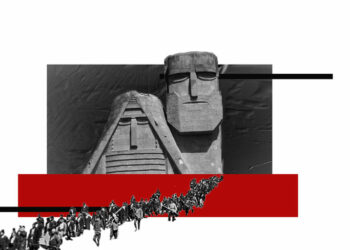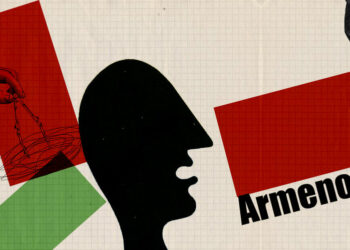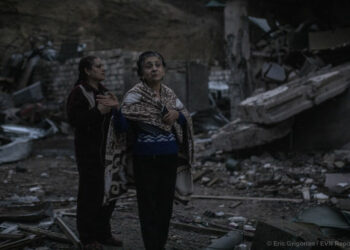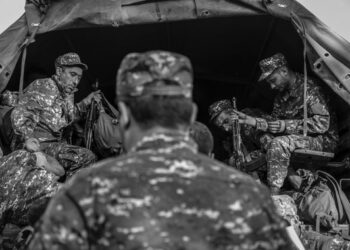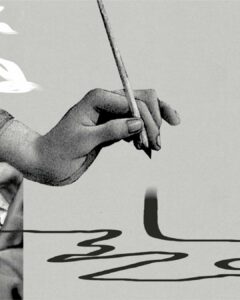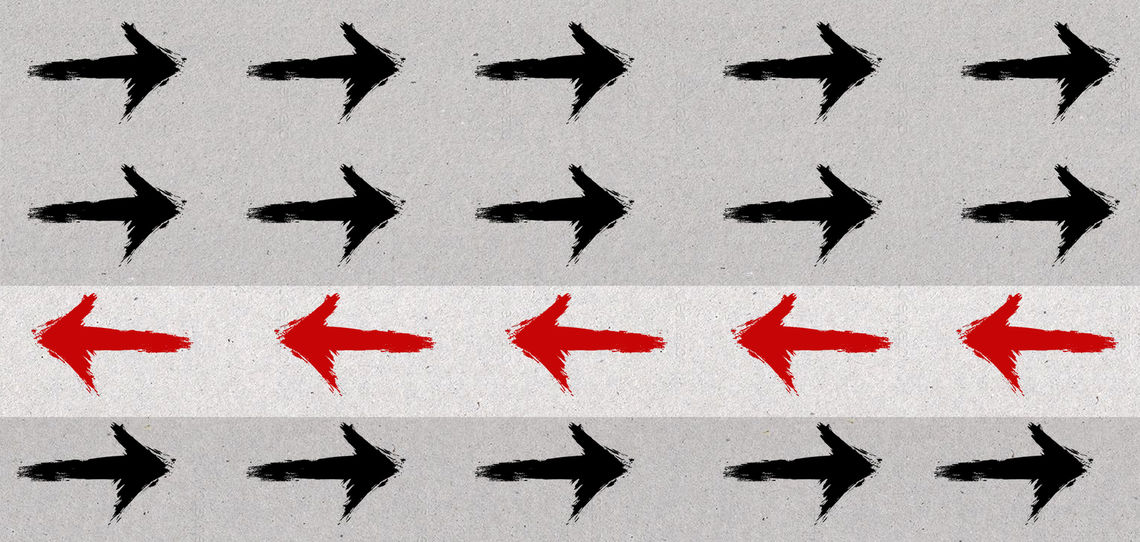

Since the first day of the 2020 Artsakh War, in addition to spreading misinformation and panic-inducing news in mass media through fake and stolen accounts, generating artificial trends on Twitter and creating staged propaganda materials, the Azerbaijani side also resorted to the method of mirror replication.
Things the international media writes about, and the international community and the Armenian side accuse Azerbaijan of, Azerbaijan “discovers” about the Armenian side. Things that happen on the Armenian side are repeated in Azerbaijan.
A number of such instances are summarized below in chronological order, revealing one of the signature styles of Azerbaijani war propaganda.
Mirror 1: Mercenaries
Reports of mercenaries from Turkish-backed militant groups being sent to Azerbaijan from the north of Syria emerged following the Armenia-Azerbaijan clashes in July of this year.
First, the Arabic media wrote about it. Then on September 21, an audio recording was published by American journalist Lindsey Snell. Her source stated that, from September 27 to 30, 1000 men from the Turkish-backed Free Syrian Army were to be sent to Azerbaijan. In her tweet, the journalist also noted having heard from multiple sources that some were already there.
On September 23, the personal details of 50 mercenaries sent to Azerbaijan were published.
Over the days following the onset of the war on September 27, reputable international platforms such as The Guardian, The Investigative Journal, Novaya Gazeta, BBC, The New York Review, The Washington Post, France 24 and others wrote about the presence of mercenaries, one after another.
French President Emanuel Macron denounced the transfer of at least 300 Syrians from Turkish-backed jihadist groups to Azerbaijan. A few days later, similar statements and concerns were voiced by Russia, including by President Vladimir Putin himself.
The U.S. warned its citizens of a risk of terrorist attacks first in Turkey, and on the following day, in Azerbaijan. Iran announced that it would not allow the presence of terrorists in the vicinity of its borders.
Despite testimonies published in the media, leaked photos and videos of participating mercenaries, and political statements, Ankara and Baku officially deny the involvement of mercenaries.
On September 28, the Azerbaijani ambassador to Turkey decided that the Armenian sides were involving armed mercenaries. He alleged that Armenia had hired militia from the Turkey-based Kurdistan Workers’ Party (PKK) to train the Armenian side in Nagorno-Karabakh and recruited fighters from the Armenian Secret Army for the Liberation of Armenia (a terrorist group from the 1980s that has been defunct for decades). These were complete fabrications but played perfectly into the “both sides” blame game.
Mirror 2: Intercepted Conversations
On October 3, the National Security Service (NSS) of Armenia released some intercepted conversations proving the involvement of Turkey and mercenary-terrorists in the military operations.
The content consisted of three parts. In the first part, certain coordinates are exchanged in Turkish and Azerbaijani. It is followed by a conversation between an Azerbaijani soldier and an Arab mercenary. The final part is a conversation between mercenaries.
Three days later, on October 6, the State Security Service of Azerbaijan released a 3-minute long video in Arabic. The supposedly intercepted content allegedly proves Baku and Ankara’s thesis that the Armenian side uses foreign mercenary-terrorists, in particular, Kurdish terrorists brought from Iraq and Syria, who are allegedly connected to the Kurdistan Workers’ Party.
The recording published by Azerbaijan is a mirror replication of the content published earlier by the Armenian side. For example, supposedly in reference to mercenaries who have just arrived in Artsakh, the person on location says, “They’ve come in vain, there are great losses and the situation is bad.” He then regrets coming himself.
The video is even careful to include an exchange in which one of them is enquiring about the presence of Turks on the battlefield (which, naturally, the interlocutor denies). This video is then presented as evidence that Turkey is not involved in the war.
The presence of Turkish F-16s was uncovered by the New York Times Visual Investigations specialist, despite continuous denial by Azerbaijan.
Mirror 3: Cluster Munitions
Footage of an attack on Stepanakert using cluster munitions was published on October 4. The following day, Amnesty International reported the use of an Israeli-made cluster bomb fired by Azerbaijan.
Cluster munitions scatter bomblets over a wide area. About a fifth of these fail to explode and pose an ongoing threat to civilians. This weapon is banned by the Convention on Cluster Munitions signed by more than 100 states. Armenia and Azerbaijan are not parties to this Convention.
Two days following this publication, late in the evening of October 6, Hikmet Hajiyev, Advisor to the President of Azerbaijan announced that Armenia had launched a cluster missile in the direction of the Baku-Tbilisi-Ceyhan oil pipeline. More than 300 cluster bombs had allegedly landed ten meters from the pipeline, but the pipeline had not been damaged in any way.
The photo published by Hajiyev, however, did not particularly convince military experts. One of them, Rob Lee, wrote on Twitter: “It seems awfully suspicious that all of those cluster munitions would land so close together, and who would pick up live [unexploded ordinances] to put them together for a photo if they landed farther apart?”
This publication by Hajiyev was followed by two (one and two) similar posts about the alleged launch of cluster munitions by Armenia in the direction of settlements.
The claims of the Armenian side have been confirmed by the international human rights organization Human Rights Watch, the representatives of which have registered four such cases in October. The organization has not been able to independently verify similar claims by Azerbaijan.
Only on October 29 did Amnesty International confirm that the Armenian side had used cluster bombs on the city of Barda the previous day.
Mirror 4: Music Among the Ruins
On Sunday, October 8, the Holy Savior Ghazanchetsots Cathedral of Shushi was shelled. This was not only an attack on spiritual and cultural heritage, but also on peaceful civilians taking refuge there and those who visit the cathedral for prayer.
Azerbaijan’s President Ilham Aliyev cast doubt that his army carried out the strike. He considered it an Armenian “provocation” fabricated to accuse Azerbaijan. Then in another interview he said that they were conducting an investigation, and if it turned out that the Azerbaijani forces had hit the cathedral, then it would have been by mistake. There were actually two separate strikes on the cathedral that day, the second while journalists were present taking photos.
Four days after this incident, a video of cellist Sevak Avanesian playing “Crane” by Komitas inside the partially-destroyed cathedral was released.
A mirror replication was then made of playing music in ruins in the Azerbaijani city of Ganja. The earliest posted video of a kamancha player that we were able to find was posted on the Instagram and Facebook accounts of Greenlight Group on October 15. In the video, the young man is not even playing the instrument.
According to the information on Facebook, this page was created in 2014 under the name of Greenlight Media Group. The word “Media” was removed from the title the following year. It provides advertising services.
Mirror 5: Medical Care for Prisoners of War
On October 16, a video appeared first in Russian and then Armenian sources showing an Azerbaijani prisoner of war receiving medical treatment in Artsakh.
Such a humanitarian approach was received with emotions, especially against the background of what had happened the day before: two Armenian prisoners of war were humiliated and executed in Hadrut. Although the Azerbaijani Defense Ministry denied the actions of its forces and called it fake, fact-checking platforms bellingcat.com and DFRLab proved that the perpetrators of the murder were the Azerbaijani Special Forces.
Two days after this incident, on October 18, Azerbaijan published photos of three captured Armenian soldiers, bandaged and lying in bed. They were visited by the Secretary of the State Commission on Prisoners of War, Missing Persons and Hostages of Azerbaijan.
Mirror 6: Confessions of Prisoners of War
On October 22 and 24, photographer Davit Ghahramayan posted short videos on his Facebook page, showing two Azerbaijani prisoners of war receiving medical treatment from the Armenian side.
The first one talked of military specialists who had come from Turkey to train them, stating that these people are still in the command posts of Azerbaijan and no decisions are made without them. The second related that, in addition to the Azerbaijani Army Units, foreign militants are also fighting against Artsakh.
On October 23, Azerbaijan also published a video of the interrogation of Armenian prisoners of war where one of them says that Kurdish mercenaries served in his military unit in Martuni and received $600 a month; their detachments were constantly exploring the area and preparing for battle. No international outlet has corroborated claims of any Kurdish involvement.
These are some examples revealing the modus operandi of Azerbaijani mirroring propaganda. With this method, the warring party aimed to keep the two sides on equal moral terms. With the use of such content, Azerbaijan puts forward certain theses of state propaganda, such as the involvement of Kurdish mercenaries on the Armenian side and that the Armenian side started the war. While the tactic did work early on as media coverage included that “both sides accuse the other of starting the war,” the approach was less successful once journalists began arriving to the area to see things for themselves. Even then, however, it created an information fog where, if one side was putting out outright lies, those looking for the truth remained confused about what to believe.
also read
War, Nothing But War: The Virtue of Brute Force and the Shortcomings of Diplomacy
The narrow geopolitical framework of the three-decade-old Karabakh conflict is now threatening to become a Eurasian nightmare: Turkey's involvement has sensationalized the war, Iran’s unease has reinforced the confusion, while Russia's perceived passiveness has created much regional anxiety.
Read moreThe Mixed Messaging of Ilham Aliyev
Armenophobic comments from Azerbaijani’s President are nothing new. He has long drummed up support among his population by promoting hatred against Armenians and using dehumanizing language, often referring to them as dogs and vermin.
Read moreYes, It Is Genocidal
The inclusion of the term genocide is not being loosely thrown around. As the war rages on, the potential for genocide against ethnic Armenians in Artsakh is very real and highly probable, writes Suren Manukyan.
Read moreUnderstanding the Aliyev Regime’s Armenophobia
The contours of Armenophobia presuppose the dehumanization of an entire people, where hatred and aversion towards an Armenian is embedded in Azerbaijan’s political culture, writes Nerses Kopalyan.
Read morephoto stories
Lives Undone
In Artsakh, there is a somber air of loss, uncertainty and grief. During 45 days of war, everyone and everything from soldiers to villagers, trees to structures were afflicted and irreversibly altered. A collection of images from November 12-14, a few days after the "peace" agreement.
Read moreA Record of War
Photojournalist Eric Grigorian captures the devastation of war, its destruction of lives, heritage sites and schools. A portrait of a nation at war, of a capital where the elderly and the grieving live underground.
Read moreA Home to War
These powerful images capture fragments of life in Artsakh, a place that is boundlessly resilient yet has too often become a home to war.
Read more


